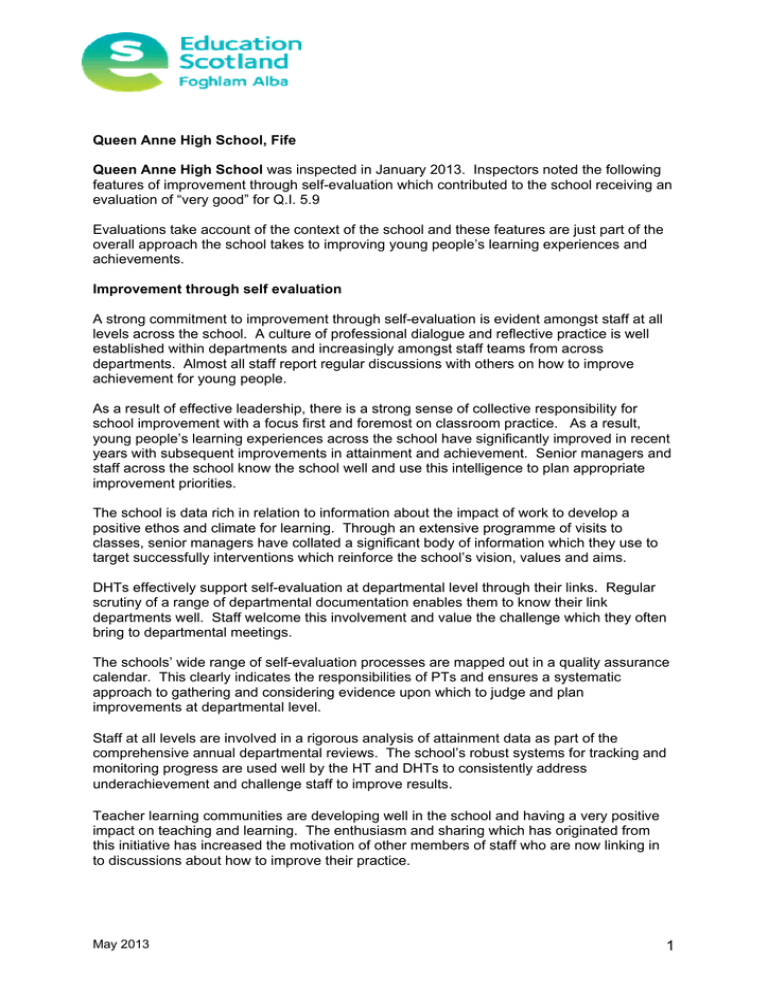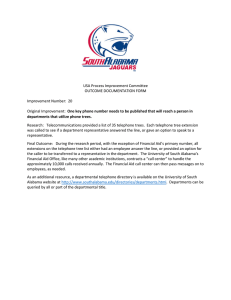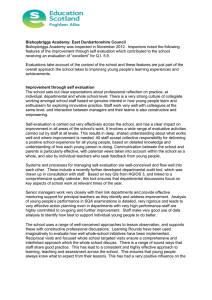Document 12954487
advertisement

Queen Anne High School, Fife Queen Anne High School was inspected in January 2013. Inspectors noted the following features of improvement through self-evaluation which contributed to the school receiving an evaluation of “very good” for Q.I. 5.9 Evaluations take account of the context of the school and these features are just part of the overall approach the school takes to improving young people’s learning experiences and achievements. Improvement through self evaluation A strong commitment to improvement through self-evaluation is evident amongst staff at all levels across the school. A culture of professional dialogue and reflective practice is well established within departments and increasingly amongst staff teams from across departments. Almost all staff report regular discussions with others on how to improve achievement for young people. As a result of effective leadership, there is a strong sense of collective responsibility for school improvement with a focus first and foremost on classroom practice. As a result, young people’s learning experiences across the school have significantly improved in recent years with subsequent improvements in attainment and achievement. Senior managers and staff across the school know the school well and use this intelligence to plan appropriate improvement priorities. The school is data rich in relation to information about the impact of work to develop a positive ethos and climate for learning. Through an extensive programme of visits to classes, senior managers have collated a significant body of information which they use to target successfully interventions which reinforce the school’s vision, values and aims. DHTs effectively support self-evaluation at departmental level through their links. Regular scrutiny of a range of departmental documentation enables them to know their link departments well. Staff welcome this involvement and value the challenge which they often bring to departmental meetings. The schools’ wide range of self-evaluation processes are mapped out in a quality assurance calendar. This clearly indicates the responsibilities of PTs and ensures a systematic approach to gathering and considering evidence upon which to judge and plan improvements at departmental level. Staff at all levels are involved in a rigorous analysis of attainment data as part of the comprehensive annual departmental reviews. The school’s robust systems for tracking and monitoring progress are used well by the HT and DHTs to consistently address underachievement and challenge staff to improve results. Teacher learning communities are developing well in the school and having a very positive impact on teaching and learning. The enthusiasm and sharing which has originated from this initiative has increased the motivation of other members of staff who are now linking in to discussions about how to improve their practice. May 2013 1 The school values the views of young people and makes effective use of their feedback to make improvements. The HT systematically meets with every young person in the school over the course of each year through the Daily Dozen. This approach effectively supports senior managers to know more about young people’s experiences across the school and to ensure any emerging issues are followed up by an appropriate member of staff. Young people feel valued and parents have confidence that staff know their children well. In departments, staff effectively seek young people’s views through for example reviews at the end of lessons, surveys of particular year groups and discussions with learners during lessons. This range of approaches increasingly ensures that young people are involved in improving the classroom experience and that their learning is stimulating and motivating. Young people can describe how the school has improved as a result of their views having been taken on board for example through the recent consultation on Curriculum for Excellence, new sports kit, the selection of charities to support and importantly, changes to courses and programmes within departments. The school seeks the views of parents through the parent council, the PTA, well attended parents evenings, surveys and parental information evenings to discuss aspects of school life such as ICT developments, uniform and Curriculum for Excellence. As a result of listening to parents the school has altered the structure of parents evenings and events to suit working parents and increased efforts to publicise the school’s achievements through the local press. Parents are better informed about their child’s progress as a result of the introduction of additional progress updates. Through the departmental review process PTs reflect on how well they are taking account of parents views. As a result of the school’s extensive consultation, parents have confidence in the direction the school is taking with Curriculum for Excellence. May 2013 2


